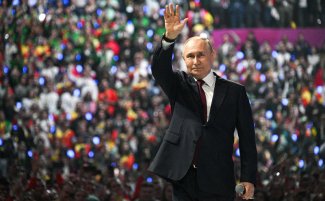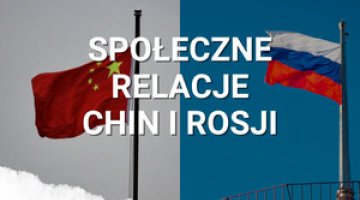Putin’s spectacle: the Soviet-style presidential ‘election’

The presidential pseudo-election on 15–17 March was orchestrated to be an unequivocal triumph for Vladimir Putin, and as proof of allegedly overwhelming public support for his policies, including the ongoing invasion of Ukraine. The authorities employed methods of manipulating and falsifying the results on an unprecedented scale, including compelling people to participate in completely opaque online voting. The record-high official result for Putin (87.3%) and turnout (77.4%), reportedly the highest in the Russian Federation’s history, are entirely unreliable. However, such results are expected to give the president carte blanche to continue his dictatorial rule – most likely for life.
The outcome of the ‘election’ is also intended to intensify pressure on the West so that it will yield to Russia’s revanchist approach to European and global security. Putin’s mandate is highly legally questionable both domestically (given the scale of the violations of the citizens’ constitutional rights) and internationally (holding the vote in occupied territories of Ukraine).
The electoral ‘special operation’ is a temporary success for the Kremlin. The government succeeded in mobilising the administrative apparatus and marginalise protest actions. This will give the ruling regime even more confidence, which will make it more determined to continue the invasion, further steer the country towards war, and escalate repression.
The electoral ‘special operation’
Putin’s ‘rivals’ were Nikolai Kharitonov (representing the Communist Party of the Russian Federation), Deputy Chair of the State Duma Vladislav Davankov (New People) and Leonid Slutsky (of the Liberal Democratic Party of Russia): these men were little-known to the Russian public and represent parliamentary parties that are fully loyal to the Kremlin and supportive of the invasion of Ukraine. According to the Central Election Commission, they received 4.3%, 3.8% and 3.2% of the votes respectively.
This ‘election’ was the most heavily rigged in the entire history of the Russian Federation. Putin’s participation was illegal because the constitutional reform of 2020, which granted him the right to seek two more six-year terms, had been carried out in violation of the then-valid 1993 constitution. Two anti-war candidates, Yekaterina Duntsova and Boris Nadezhdin, were not allowed to run in the election. Voting also took place in the occupied territories of Ukraine, which was a violation of international law (see below).
This ‘election’ was primarily intended to demonstrate to Russians and the West that Putin enjoys overwhelming public support, and was supposed to legitimise his increasingly neo-totalitarian rule and the ongoing war. It was also an occasion to test the efficiency of the administrative apparatus, which was expected to produce the results desired by the Kremlin against the backdrop of public disorientation about the real goals of the invasion, the growing support for peace talks (albeit on Russian terms), and the country’s expanding economic problems.
For domestic policy needs, efforts were made to prove that the regime’s opponents are on the margins of society and, as ‘traitors’ and ‘foreign agents’, are not part of the nation. The intention was to paralyse any will to resist and undermine the belief that change is possible. The ability to mobilise the whole of the state machinery in pursuit of Putin’s record-high result has also solidified his dictatorial position within the power elite. The ‘election’s results prove that the Kremlin is the only decision-making centre to have real influence on the country’s policies and is also meant to strengthen Russia’s image in the countries of the Global South and increase pressure on the West to accept Russia’s revanchist demands regarding European and global security architecture.
The domestic political context of the ‘election’
The full-scale invasion of Ukraine and the ‘existential’ war with the West have been used as a pretext to adopt a totalitarian course in domestic policy. As a result of mass censorship, surveillance, indoctrination and repression, all forms of protest against the war and the regime have effectively been outlawed. The most prominent opponents of the Kremlin have either been sent to prison, forced into exile or eliminated. The death of Alexei Navalny, the strongest democratic opposition leader, who was killed in prison in mid-February, especially helped the government reassert its claim that Putin will remain the only possible leader.
The Russian public is being ever more frequently compelled to actively engage in ‘patriotic’ rituals glorifying aggressive imperialism. At the same time, the main factors that determine the declared high public support for Putin include a sense of the lack of any alternatives, awareness of the threat posed by the war (which is presented as a defensive war for the survival of the state and the Russian people), general fatalism and a lack of other collective identity than the imperial identity dictated by the state. In pre-election surveys conducted by the independent centre Russian Field, 85% of respondents who were determined to vote for a specific candidate said they would vote for the incumbent president (while 41% would support an ‘alternative’ contender if one appeared). However, in the reality of contemporary Russia, such declarations have nothing to do with the real electoral sentiments of the public. The fact that the government employed illegal mechanisms to ensure the desired official results of the plebiscite on such a massive scale seems to be a sign of the Kremlin’s uncertainty about its outcome.
Voting under the Kremlin’s watchful eye
A characteristic feature of this year’s ‘election’ was the widespread, systematic coercion to participate, which especially targeted those groups who are dependent on the state. These included employees of various levels of public administration, the public sector and state-owned enterprises (as well as numerous private companies), students and the parents of schoolchildren. Very strong pressure was put on people to vote online; this was the first time when this form of voting was used for presidential elections. It was implemented in 27 out of 83 regions of the Russian Federation, and the occupied territories of Ukraine, Crimea and Sevastopol. It was mostly introduced in areas where the opposition had previously achieved relatively good results, including Moscow. This type of voting is entirely non-transparent in Russian conditions and allows for arbitrary ‘adjustment’ of the results.
The government estimates the total number of voters casting their ballots online to be at least 7.5 million (including a minimum of 3.4 million in the capital). However, it is impossible to verify this data. Voters were also coerced in various ways to vote online on 15 March, which was a working day, so employers or universities could control the process. The uncertainty about the confidentiality of online voting may have also inclined voters to cast their ballots for the incumbent president. After the first day of the ‘elections’, the official turnout in online voting already exceeded 70% in some regions, compared to 60% in traditional voting. This contrasted with the findings of the state-run VTsIOM poll on 15 March, according to which only 14% of respondents considered voting on a workday convenient.
Of particular interest are the significant increases in ‘support’ for Putin compared to the 2018 elections in those federal areas which are considered problematic for the Kremlin (such as Yakutia, Primorsky krai and the Jewish Autonomous Oblast). Putin also achieved a ludicrously high official result (98.99%) in Chechnya; he also reportedly garnered high support in the regions bordering Ukraine which are affected by the hostilities: Belgorod, Bryansk and Kursk (despite multiple missile alerts in Belgorod oblast, a record turnout of 66% was announced after the first day of the ‘elections’). At the same time, the government sought to lower turnout among the opposition or anti-war electorate. Participation in unsanctioned actions was also prohibited (see below).
The most common irregularities registered by the independent organisation Golos included mass rigging of voting precincts, anomalies regarding official turnout (such as identical figures reported by dozens of electoral commissions in a given region, or a sudden increase in turnout correlated with voting for one candidate), a lack of access to video broadcasts from polling stations, stuffing of ballot boxes, or violations of rules regarding the storage of cast votes. Cases of police violating the secrecy of voting were reported. Independent observation was practically impossible as the electoral commissions were dominated by individuals fully loyal to the Kremlin.
Numerous incidents occurred at electoral commissions during the three days of voting. Independent media reported nearly 40 situations in which voters attempted to destroy ballot boxes and voting sheets or set fire to polling stations, as well as false bomb alerts. According to the Ministry of Internal Affairs, 61 criminal cases related to disrupting the voting process had been initiated by the evening of 17 March. A total of at least 89 people were detained in 22 cities (data from OVD-Info), some for writing anti-Putin slogans on ballots.
The opposition’s voice: ‘Noon against Putin’
Since all forms of anti-war and anti-Putin protest have been effectively outlawed, the majority of the democratic opposition collectively called on citizens to gather at polling stations on 17 March at a set time (12:00 local time) to protest against the president in any way they saw fit (some suggested voting for Davankov as the least pro-war candidate, while others suggested writing Navalny’s name or anti-Putin slogans on the ballots). Activists from the previously apolitical movement of mothers and wives of mobilised soldiers, who have unsuccessfully been demanding the rotation of Russian soldiers on the front lines, also joined the action. This is a sign that the movement is becoming politicised and radicalised.
The aim of the initiative was to undermine the Kremlin’s triumphant narrative discrediting anti-regime groups as marginal, and to express protest in the only legal (albeit still risky) way. Queues formed outside polling stations in regional centres in the Far East, Siberia, the Urals and the European part of Russia. The overall estimated number of participants is between several thousand and little more than ten thousand, which can hardly be called a success. Much larger gatherings were seen outside Russia. The government had warned against participating in the action, labelling it as ‘extremist’. There were also reported cases of voting being suspended for several hours to discourage voters.
The Kremlin’s propaganda presented the official results of the ‘election’, including the allegedly record-high turnout, as an expression of the citizens’ immense engagement in the country’s affairs and the consolidation of the nation around the leader. Considerable attention was paid to the ‘grateful’ residents of the occupied territories of Ukraine for being included into Russia. The West and Kyiv were, as usual, accused of attempting to interfere in the electoral process and destabilise the country.
Residents of the occupied territories forced to vote
The plebiscite in the occupied territories of Ukraine began on 13 March and was called ‘premature’ by the occupation authorities. According to official reports, the turnout in the areas of the Donetsk, Luhansk, Zaporizhzhia and Kherson oblasts controlled by Russia exceeded 80%. However, these figures, as well as the reported number of voters, are entirely unreliable. The ‘voting’ was, in fact, a special operation conducted under the supervision of Russian security services and the military, and the ballots were filled out by unauthorised individuals.
To ensure a high turnout, the contingent of law enforcement forces stationed in these areas (including units of the National Guard) had been reinforced weeks before the ‘election’. Soldiers fighting on the front lines also participated in the plebiscite. Votes were also cast on behalf of individuals listed in the registers of military units as having been killed or missing in action. ‘Flying voting’ was also practiced: votes were collected from people on the streets or at their residences, even though the occupiers do not have accurate population registers. Both holders of Ukrainian passports and migrant workers from Central Asia employed in the occupied territories (estimated at 100,000) were forced to vote. Ensuring high turnout by all means was part of a larger disinformation operation aimed at adding legitimacy to the narrative that the situation in the unlawfully annexed territories is allegedly ‘normal’, and that the local population enthusiastically supports Putin’s policies.
Ukrainian military intelligence (HUR) took steps to disrupt the ‘election’ in the border oblasts of Belgorod and Kursk. Units composed of Russians fighting on the side of Kyiv have been operating there since 11 March as part of a sabotage operation. Soldiers from the Russian Volunteer Corps, the Free Russia Legion and the Sibir Battalion seized control of several villages following clashes with Russian forces. Their actions were supported by Ukrainian forces. Despite the threat to civilians, the Russian authorities did not suspend or limit the voting. On 15 March, HUR reported that Ukrainian hackers had disrupted the operation of the government administration services website which was being used for online voting. Residents of Moscow, Tyumen, Novosibirsk and other cities had problems accessing it.
The Ukrainian side, aiming to underscore the invalidity of Putin’s ‘election’ in the occupied territories, issued a joint statement with 57 UN member states (including all the EU members). Its signatories condemned Russia’s illegitimate attempts to organise presidential elections in temporarily occupied areas of Ukraine “in the strongest terms”. It was emphasised that holding elections on the territory of another UN member state without its consent went in manifest disregard for the principles of sovereignty and territorial integrity, and that such elections have no validity under international law.
The consequences of the ‘election’
In the context of the Kremlin’s totalitarian domestic policy, the government’s stance during the ‘election’ reflects a growing assertiveness, the casting aside of any previous pretences, and a prioritisation of coercion as the primary tool for governing society. The electoral ‘special operation’ has, at least in the short term, to be viewed as a success for Moscow: the administrative apparatus was mobilised on an unprecedented scale, and major protest actions were prevented.
The Kremlin’s confidence is set to grow after the ‘election’; this will be matched by its determination to continue the invasion and blackmail of the West, and lead to a further shift of the country towards a war footing and intensifying repression. The Western countries’ visible lack of political will to unequivocally brand Putin as a usurper will contribute to the legitimisation of his power, both at home and on the international stage.




